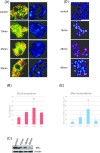In Situ Evaluation of Estrogen Receptor Dimers in Breast Carcinoma Cells: Visualization of Protein-Protein Interactions
- PMID: 28522883
- PMCID: PMC5433938
- DOI: 10.1267/ahc.17011
In Situ Evaluation of Estrogen Receptor Dimers in Breast Carcinoma Cells: Visualization of Protein-Protein Interactions
Abstract
The estrogen receptor (ER) functions as a dimer and is involved in several different biological functions. However ER dimeric proteins have not been identified by in situ methodologies. Structured illumination microscopy (SIM) has been recently developed, which enabled the localization of protein and protein interaction. Therefore, in this study, we firstly demonstrated that ERs formed both homodimers and heterodimers in breast carcinoma cell lines using Nikon's SIM (N-SIM). ERα/α homodimers were detected in the nuclei of both ERα-positive MCF-7 and T-47D cells; 23.0% and 13.4% of ERα proteins formed ERα/α homodimers, respectively. ERα/β heterodimers were also detected in MCF-7 and T-47D. Approximately 6.6% of both ERα and ERβ1 proteins formed ERα/β1 heterodimers in MCF-7. In addition, 18.1% and 22.4% of ERα and ERβ proteins formed ERα/β2 heterodimers and ERα/β5 heterodimers in MCF-7, respectively. In addition, by using proximity ligation assay (PLA) in MCF-7, estradiol-induced ERα/α homodimers and ERα/β1 heterodimers were both detected after 15 to 45 min of treatment and at 15 min, respectively. The percentage of total ER proteins could also be determined using N-SIM. By using both methods, it has become possible to evaluate precise localization and ratio of ER dimers among different cell types.
Keywords: breast cancer; estrogen receptor dimer; protein-protein interaction; proximity ligation assay; structured illumination microscopy.
Figures





Similar articles
-
In situ detection of estrogen receptor dimers in breast carcinoma cells in archival materials using proximity ligation assay (PLA).J Steroid Biochem Mol Biol. 2017 Jan;165(Pt B):159-169. doi: 10.1016/j.jsbmb.2016.05.022. Epub 2016 Jun 2. J Steroid Biochem Mol Biol. 2017. PMID: 27264933
-
Oestrogen receptors pathways to oestrogen responsive elements: the transactivation function-1 acts as the keystone of oestrogen receptor (ER)beta-mediated transcriptional repression of ERalpha.J Steroid Biochem Mol Biol. 2007 May;104(3-5):110-22. doi: 10.1016/j.jsbmb.2007.03.002. Epub 2007 Mar 12. J Steroid Biochem Mol Biol. 2007. PMID: 17478088
-
Single-chain estrogen receptors (ERs) reveal that the ERalpha/beta heterodimer emulates functions of the ERalpha dimer in genomic estrogen signaling pathways.Mol Cell Biol. 2004 Sep;24(17):7681-94. doi: 10.1128/MCB.24.17.7681-7694.2004. Mol Cell Biol. 2004. PMID: 15314175 Free PMC article.
-
Transcriptional regulation of vascular endothelial growth factor by estradiol and tamoxifen in breast cancer cells: a complex interplay between estrogen receptors alpha and beta.Cancer Res. 2002 Sep 1;62(17):4977-84. Cancer Res. 2002. PMID: 12208749
-
Estrogen signaling: a subtle balance between ER alpha and ER beta.Mol Interv. 2003 Aug;3(5):281-92. doi: 10.1124/mi.3.5.281. Mol Interv. 2003. PMID: 14993442 Review.
Cited by
-
Co-expression of carcinoembryonic antigen-related cell adhesion molecule 6 and 8 inhibits proliferation and invasiveness of breast carcinoma cells.Clin Exp Metastasis. 2019 Oct;36(5):423-432. doi: 10.1007/s10585-019-09981-2. Epub 2019 Jun 20. Clin Exp Metastasis. 2019. PMID: 31222613
-
Heterogeneous Nuclear Ribonucleoprotein K Is Involved in the Estrogen-Signaling Pathway in Breast Cancer.Int J Mol Sci. 2021 Mar 4;22(5):2581. doi: 10.3390/ijms22052581. Int J Mol Sci. 2021. PMID: 33806648 Free PMC article.
-
Role of Cancer Stem-like Cells in the Process of Invasion and Mesenchymal Transformation by a Reconstituted Triple-negative Breast Cancer Cell Population Resistant to p53-induced Apoptosis.Acta Histochem Cytochem. 2022 Oct 28;55(5):169-184. doi: 10.1267/ahc.22-00076. Epub 2022 Oct 25. Acta Histochem Cytochem. 2022. PMID: 36405550 Free PMC article.
-
Exploring Protein⁻Protein Interaction in the Study of Hormone-Dependent Cancers.Int J Mol Sci. 2018 Oct 15;19(10):3173. doi: 10.3390/ijms19103173. Int J Mol Sci. 2018. PMID: 30326622 Free PMC article. Review.
-
The Visualization of Protein-Protein Interactions in Breast Cancer: Deployment Study in Pathological Examination.Acta Histochem Cytochem. 2021 Dec 24;54(6):177-183. doi: 10.1267/ahc.21-00084. Epub 2021 Nov 18. Acta Histochem Cytochem. 2021. PMID: 35023880 Free PMC article. Review.
References
-
- Bai Y. and Giguére V. (2003) Isoform-selective interactions between estrogen receptors and steroid receptor coactivators promoted by estradiol and ErbB-2 signaling in living cells. Mol. Endocrinol. 17; 589–599. - PubMed
-
- Batmunkh B., Choijookhuu N., Srisowanna N., Byambatsogt U., Synn Oo. P., Noor Ali, M., Yamaguchi Y. and Hishikawa Y. (2017) Estrogen accelerates cell proliferation through estrogen receptor α during rat liver regeneration after partial hepatectomy. Acta Histochem. Cytochem. 50; 39–48. - PMC - PubMed
-
- Chantzi N. I., Tiniakos D. G., Palaiologou M., Goutas N., Filippidis T., Vassilaros D. S., Dhimolea E., Mitsiou J. D. and Alexis N. M. (2013) Estrogen receptor beta 2 is associated with poor prognosis in estrogen receptor alpha-negative breast carcinoma. J. Cancer Res. Clin. Oncol. 139; 1489–1498. - PMC - PubMed
-
- Cowley S. M., Hoare S., Mosselman S. and Parker M. G. (1997) Estrogen receptors alpha and beta form heterodimers on DNA. J. Biol. Chem. 272; 19858–19862. - PubMed
LinkOut - more resources
Full Text Sources
Other Literature Sources

